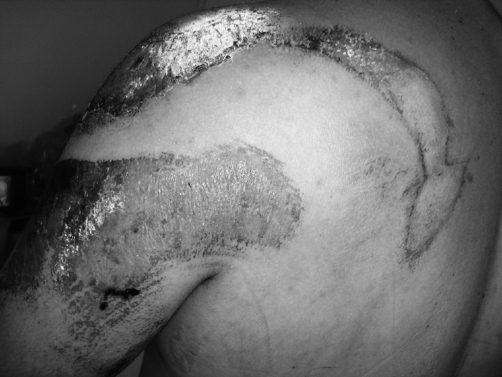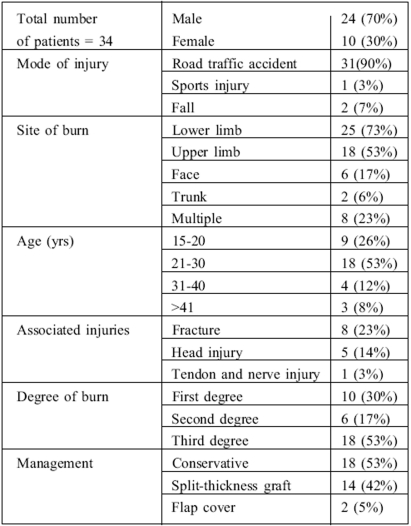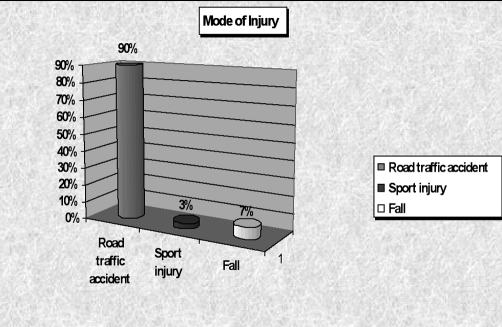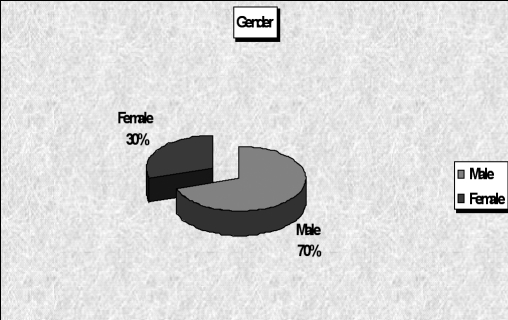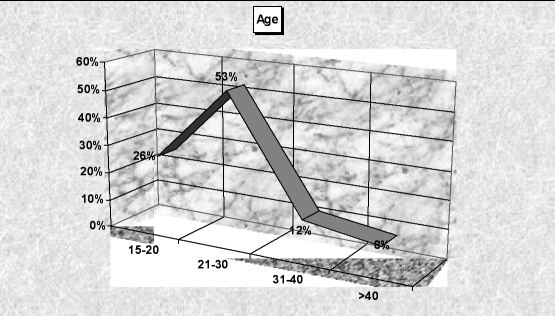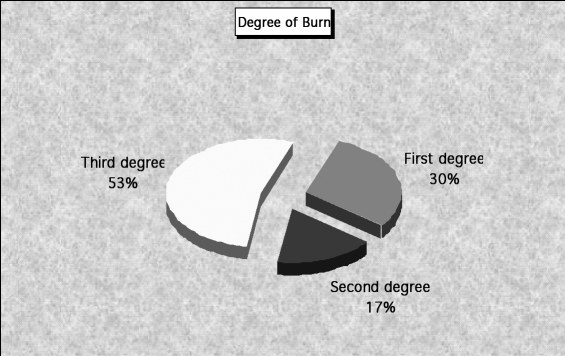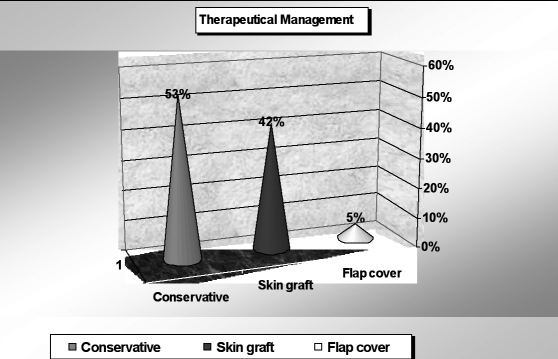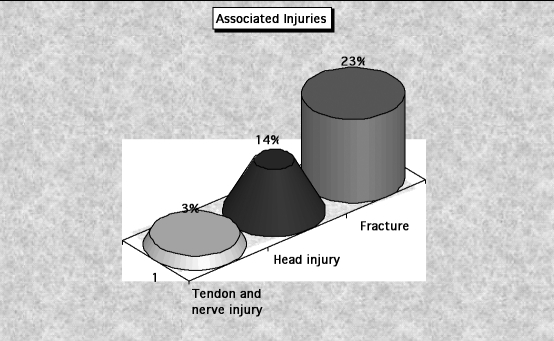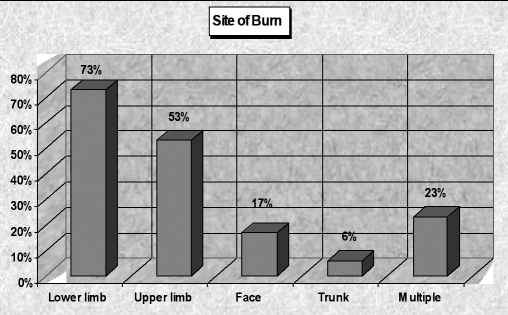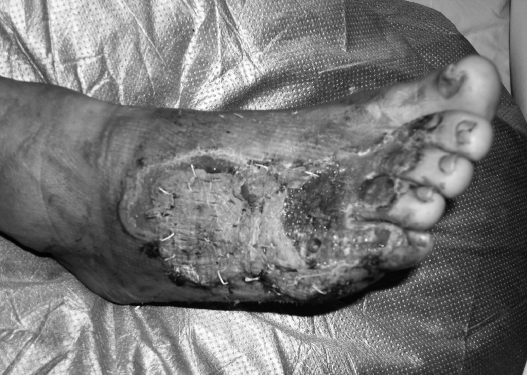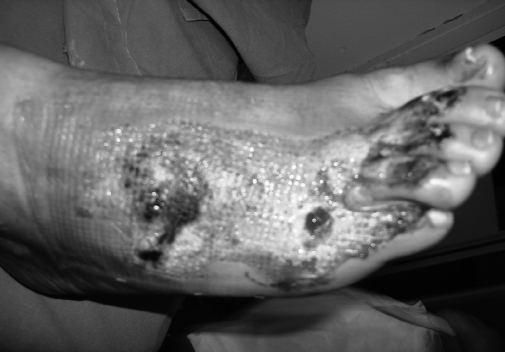Summary
This epidemiological study deals with 34 patients with friction burns sustained between January 2007 and January 2008. The age group most affected was that between 21 and 30 yr, with a male predominance. Road traffic accidents were the commonest cause of friction burns (31 patients) and the lower limb was body part most commonly affected. The therapy was mostly conservative (no. 18): 14 patients were treated with a split-thickness skin graft, and just two with flap cover. Friction burns are overlooked in the emergency department because of their association with more critical mechanical injuries. They can be prevented by observing standard safety measures such as special clothing or appropriate equipment, especially as regards motorcycle riders.
Keywords: TRAUMATIC, INJURIES, DEEP ABRASION, BURN
Abstract
Les Auteurs de cette étude considèrent 34 patients atteints de brûlures causées par la friction entre janvier 2007 et janvier 2008. Les patients âgés de 21 à 30 ans constituaient le groupe le plus communément intéressé par ce type d'accident, avec une prévalence du sexe masculin. La plupart des lésions par friction étaient causées par les accidents de la route (31 patients) et le membre supérieur était la partie du corps la plus touchée. La thérapie était normalement conservatrice (18 patients), 14 patients ont reçu une greffe cutanée d'épaisseur variable, et seulement deux ont reçu une couverture à lambeau. Quelquefois on ne s'aperçoit pas que certaines brûlures sont causées par la friction à cause de l'association d'autres lésions d'origine mécanique plus graves. Il est possible de prévenir ce type de brûlure en observant les mesures normales de sécurité, comme par exemple porter des vêtements particuliers ou un équipement approprié, particulièrement pour ce qui concerne les motocyclistes.
Introduction
A friction burn occurs when the skin is scraped off by contact with some hard object, such as the road, the floor, etc. or by prolonged contact with a smooth surface (exercise treadmill). It cannot be determined if friction burns are due only to the forces of friction or also to the buildup of heat. In both circumstances, the management of friction burns is the same as in thermal burns, with the administration of intravenous fluids and shock resuscitation in the case of extensive burns and topical therapy using antiseptic and/or antimicrobial agents. It is usually both an abrasion and a heat burn. Friction burn injuries are commonly seen following road traffic accidents, mainly in motorcycle or bicycle riders, while other modes are sports injuries, the use of an exercise treadmill at home, fast moving belts in factories, rolling belts used in agriculture, tourniquets applied over the thigh without proper padding, and domestic vacuum cleaners which cause friction burns in young children (Fig. 1). The incidence of friction burns is reasonably high but the majority of patients do not report to hospital for treatment, as most of them have only minor burns. Friction burns are not even included in burns surveys. A friction burn can occur in any part of the body but these types of scrapes usually affect bony areas, such as the hands, forearms, elbows, knees, or chins. They are more painful than cuts because such scrapes tear a larger area of skin and expose more nerve endings. In the head and neck areas they may appear worse than they are, bleeding a lot because of the ample blood supply in these areas. Most friction burns are second- or third-degree and, if untreated, commonly lead to infection and scar formation with contracture of the scar due to pigmented particles (mainly stones) that are accidentally introduced as contaminants during in road accidents, creating skin-like tattoos. The general therapeutic approach is mainly topical and includes:
Fig. 1. Friction burn.
assessment of the severity of the wound
possible degloving injuries
surgical debridement and escharectomy
placement of split- or full-thickness skin graft or flap cover
Our study highlights the epidemiology and preventive aspects of friction burns.
Patient data include sex, age, mode of injury, other associated injuries, degree of burn, and wound management.
All the patients were admitted to the plastic surgery ward and the burn wounds were managed according to the degree of burn injury with tetanus prophylaxis, local wound treatment, tangential excision and split-thickness graft or flap cover.1,2,3,4,5,6,7,8
Materials and methods
This prospective study covers 34 patients with friction burns who presented to us from January 2007 to January 2008 (Table I).
Table I. The patients.
Thirty-four patients were included in the study, aged from 15 to over 41 years old. The largest age group was that of patients in the 21-to 30-yr-old group (no. 18/53%) and the smallest that of patients aged 41 yr and over (no. 3/8%). Of the 34 patients, 24 (70%) were male and 10 (30%) were female.
Thirty-one patients (90%) sustained their burns in road traffic accidents, while in three patients (10%) the burns were due to sports injuries or falls from height (Figs. 2 - 3 - 4).
Fig. 2. Mode of injury.
Fig. 3. Sex distribution.
Fig. 4. Age.
The body parts most often affected were the lower limb (25 patients/73%), followed by the upper limb (18/53%), the face (6/17%), and other parts. Most of these were associated with other injuries, such as bone fracture (8 patients/23%), head injury (5/14%), and tendon and nerve injury (1/3%). Of the 34 patients, 18 (53%) had full-thickness burns (third degree), six had second-degree burns (17%), and ten had first-degree burns (30%).
Patient management was performed according to the degree of burn, with conservative treatment in 18 patients (53%), while split-thickness skin graft was performed in 14 patients (42%). In two patients (5%), flap cover was provided for the part by third-degree burns (Figs. 5 - 6 - 7 - 8).
Fig. 5. Degree of burn.
Fig. 6. Therapeutic management.
Fig. 7. Associated injuries.
Fig. 8. Site of burn.
Fig. 10. Severe foot burn.
Discussion
Burn injury is a common health problem, but burns due to friction have been ignored and overlooked. This is probably because in the majority of patients friction burns are usually associated with more severe mechanical injuries (bone fractures and vessel or muscle ruptures). Hence the burn is ignored and the mechanical injury becomes the priority (Fig. 9)
Fig. 9. Foot burn.
Friction is the non-conservative resistive force that occurs when two surfaces move against each other after being forced into contact. This causes physical deformation and heat build-up.
When some part of the human body rubs against a hard object, the coefficient of friction is very high and thus produces a large amount of heat energy.
Most friction burns are minor, superficial degree burns, while burns suffered in road accidents due to sliding force, producing a very high degree of heat energy, lead to fullthickness deep burn injuries that require debridement and graft or flap coverage.
The severity of such burns depends on the speed of the moving vehicle and the hard surface that the body part rubs against. The severity of the burn is less when the body part is covered by clothing.
In our study, two patients had full-thickness burns in the lower or upper limb.
Prevention and conclusion
Preventive measures include:
Wearing protective clothing, a helmet, and shoes while riding a motorcycle.
Using protective pads over the knee and elbow and wearing shoes while engaged in sport.
Preventing road accidents by government enforcement of traffic speed regulations.
First of all, to increase prevention, people have to be properly informed and take appropriate precautions at work, at home, in sport, or riding a motorcycle or bicycle, as most of the burns we have discussed were preventable. Unless they are full thickness, friction burns do not usually require any surgical intervention.
References
- 1.Lanz U., Keller H.P. Abrasion injuries, combined burn injury of the hand. Hand Chir. Mikrochir. Plas. Chir. 1985;17:348–350. [PubMed] [Google Scholar]
- 2.Karoon Agrawal. Friction burn. Indian J. Burns. 2003;11:28–29. [Google Scholar]
- 3.Pegg S., Mayzee T.D. Burn injuries associated with motorcycles. Burns. 1982;9:288–288. doi: 10.1016/0305-4179(83)90060-8. [DOI] [PubMed] [Google Scholar]
- 4.Borschel B.H., Wolter K.G., Cederna P.S., Franklin G. Acute management of exercise treadmill associated injuries in children. J. Trauma. 2003;55:130–134. doi: 10.1097/01.TA.0000033497.74240.5F. [DOI] [PubMed] [Google Scholar]
- 5.Tipler P. "Physics for Scientists and Engineers" (4th edition) 1998;1 [Google Scholar]
- 6.Al-Qattam M.M. Car tyre friction injuries in children. Burns. 2000;26:399–399. doi: 10.1016/s0305-4179(99)00130-8. [DOI] [PubMed] [Google Scholar]
- 7.Adani R., Tarallo L., Marcoccio I. Island radial artery fasciocutaneous flap for dorsal hand reconstruction. Annals Plastic Surgery, 47: 83-5, . 2001;47:83–85. doi: 10.1097/00000637-200107000-00015. [DOI] [PubMed] [Google Scholar]
- 8.Ono I., Tateshita T. Reconstruction of a full-thickness defect of the chest wall caused by friction burn using a combined myocutaneous flap of teres major and latissimus dorsi. Burns. 2001;27:283–283. doi: 10.1016/s0305-4179(00)00107-8. [DOI] [PubMed] [Google Scholar]



